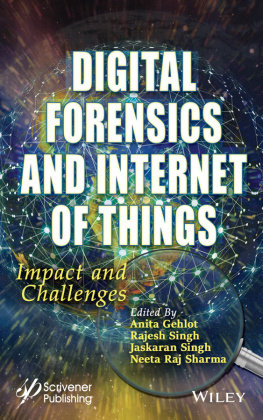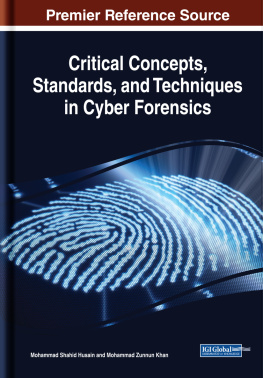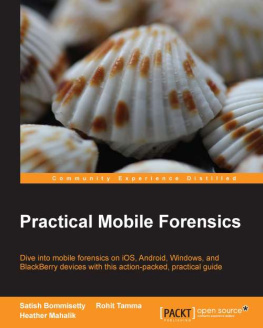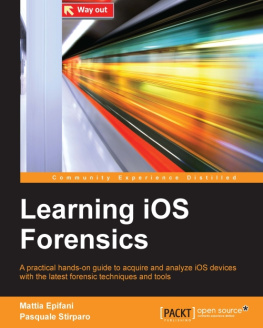
Scrivener Publishing
100 Cummings Center, Suite 541J
Beverly, MA 01915-6106
Publishers at Scrivener
Martin Scrivener ()
Phillip Carmical ()
Digital Forensics and Internet of Things
Impact and Challenges
Edited by
Anita Gehlot
Uttaranchal Institute of Technology, Uttaranchal University, India
Rajesh Singh
Uttaranchal Institute of Technology, Uttaranchal University, India
Jaskaran Singh
Forensic Sciences, Sharda University, Indiaand
Neeta Raj Sharma
Biotechnology & BioSciences, Lovely Professional University, India

This edition first published 2022 by John Wiley & Sons, Inc., Ill River Street, Hoboken, NJ 07030, USA and Scrivener Publishing LLC, 100 Cummings Center, Suite 541J, Beverly, MA 01915, USA 2022 Scrivener Publishing LLC
For more information about Scrivener publications please visit www.scrivenerpublishing.com.
All rights reserved. No part of this publication may be reproduced, stored in a retrieval system, or transmitted, in any form or by any means, electronic, mechanical, photocopying, recording, or otherwise, except as permitted by law. Advice on how to obtain permission to reuse material from this title is available at http://www.wiley.com/go/permissions.
Wiley Global Headquarters
111 River Street, Hoboken, NJ 07030, USA
For details of our global editorial offices, customer services, and more information about Wiley products visit us at www.wiley.com.
Limit of Liability/Disclaimer of Warranty
While the publisher and authors have used their best efforts in preparing this work, they make no representations or warranties with respect to the accuracy or completeness of the contents of this work and speciically disclaim all warranties, including without limitation any implied warranties of merchantability or fitness for a particular purpose. No warranty may be created or extended by sales representatives, written sales materials, or promotional statements for this work. The fact that an organization, website, or product is referred to in this work as a citation and/or potential source of further information does not mean that the publisher and authors endorse the information or services the organization, website, or product may provide or recommendations it may make. This work is sold with the understanding that the publisher is not engaged in rendering professional services. Te advice and strategies contained herein may not be suitable for your situation. You should consult with a specialist where appropriate. Neither the publisher nor authors shall be liable for any loss of proit or any other commercial damages, including but not limited to special, incidental, consequential, or other damages. Further, readers should be aware that websites listed in this work may have changed or disappeared between when this work was written and when it is read.
Library of Congress Cataloging-in-Publication Data
ISBN 978-1-119-76878-4
Cover image: Pixabay.Com
Cover design by Russell Richardson
Set in size of 11pt and Minion Pro by Manila Typesetting Company, Makati, Philippines Printed in the USA
10 9 8 7 6 5 4 3 2 1
Preface
This book provides an opportunity to readers in the era of digitalization of forensic science and application of Internet of Things for the provision of technical benefits to the stakeholders. IoT forensics attempts to align its workflow to that of any forensics practiceinvestigators identify, interpret, preserve, analyse and present any relevant data. Like any investigation, a timeline is constructed, and, with the aid of smart devices providing data, investigators might be able to capture much more specific data points than in a traditional crime.
Currently, there exists no defined and accepted standard for IoT forensic investigations. This can be attributed in part to the heterogeneous nature of IoT.
discuss the core aspects of machine learning in the areas of healthcare, criminal profiling and digital cyber investigation.
Cyber and digital frauds are the hallmark of todays era. There is an urgent need to produce knowledgeable resources for curbing such crimes; thus, this book will serve as a perfect instance for getting the best source of expertise. Additionally, it serves as a revolutionary merit for identification and apprehension of criminals in a smarter way.
Case studies related to digital and cyber forensics is a key feature of the book. The content of chapters serves as a jewel in the crown for law enforcement agencies, advocates, forensic experts and students. Hence, we hope the book is an asset for readers and users as they become aware of the ubiquitous societal issues of digital and cybercrimes. Finally, we owe a large debt of gratitude to Scrivener Publishing and Wiley and all authors of the book in particular, for their continued support and patience.
Prof. (Dr.) Anita Gehlot
Uttaranchal University, India
Prof. (Dr.) Rajesh Singh
Uttaranchal University, India
Dr. Jaskaran Singh
Sharda University, India
Dr. Neeta Raj Sharma
Lovely Professional University, India
The Editors
February 2022
Face RecognitionBased Surveillance System: A New Paradigm for Criminal Profiling
Payal Singh, Sneha Gupta, Vipul Gupta, Piyush Kuchhal and Arpit Jain
Electrical and Electronics Engineering Department, UPES, Dehradun, India
Abstract
Security is the most important aspect in any spheres. We have to ensure these technologies evolve along with the advancement of various technology in the field of machine vision and artificial intelligence. The system of facial detection has become a topic of interest. It is widely used for human identification due to its capabilities that give accurate results. It is majorly used for security purposes. This manuscript provides method of face detection and its applications. Using this method, locking system will be designed to ensure safety and security in all types of places. Surveillance systems help in close observation and looking for improper behavior. Then, it performs actions on the data that has been provides to it.
Keywords: Face recognition, python, Raspberry Pi, deep learning, locking system, image processing, eigen faces, fisher faces
1.1 Introduction
Face detection is the method which is pre-owned to identify or verify an individuals identity using their face. There can also be image, video, audio, or audio-visual element given to the system. Generally, the data is used to access a system or service. This can be performed in two variations depending on its application. First is when the facial recognition system is taking the input (face) for the first time and registering it for analysis. Second is when the user is authenticated prior to being registered. In this, the incoming data is checked from the existing data in the database, and then, access or permission is granted.
The most important aspect of any security system is to properly identify individuals entering or taking an exit through the entrance. There are several systems that use passwords or pins for identification purposes. But these types of systems are not very effective as these pins and passwords can be stolen or copied easily. The best solution to this is using ones bio-metric trait. These are highly effective and useful. This system is designed for prevention of security threats in exceptionally secure regions with lesser power utilization and more dependable independent security gadget.
Next page






